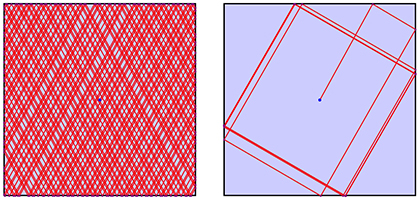Suppose that a billiard ball bouncing in a unit square (or a lightray reflecting in a mirrored square) has the property that the angle of reflection is a fraction of the angle of incidence, rather than equal to it. What are the dynamics?
I explored this a bit with the angle of reflection $\frac{1}{2}$ the angle of incidence, and was surprised to discover that, regardless of the starting angle, the path quickly converges to follow $30^\circ{-}60^\circ{-}90^\circ$ triangles:

This is because (a) the ray alternates hitting a vertical and a horizontal square side, i.e., it never bounces twice in a row on opposing horizontal or opposing vertical sides, and (b) $\alpha = (\pi/2 - \alpha)/2$ solves to $\alpha=\pi/6$.
Moreover, the filling behavior is quite different. Left below shows standard ergodic billiard dynamics when the angle of reflection is equal to the angle of incidence, while the right image shows the path starting with the same irrational slope, where the angle of reflection is half the angle of incidence, both for $200$ reflections.

This remarkably predictable behavior has made me wonder (1) what are the periodic orbits in the square for the $\frac{1}{2}$-reflection paths illustrated above, (2) what might be the dynamics when reflection angles are some other fraction of the incident angles, and (3) when the "billiard table" is a nonsquare rectangle, or other some convex shape. Perhaps these questions have been explored. If so, I would appreciate pointers—Thanks!
